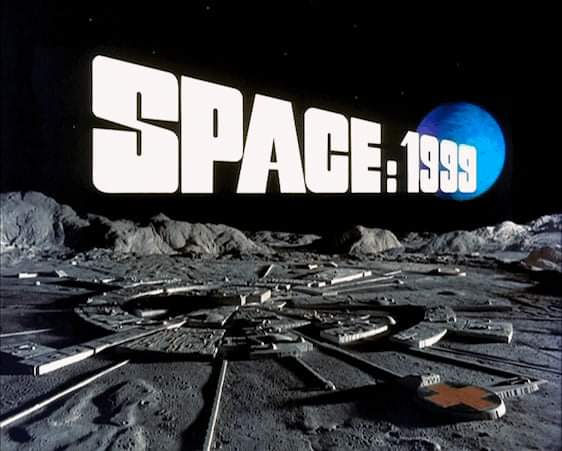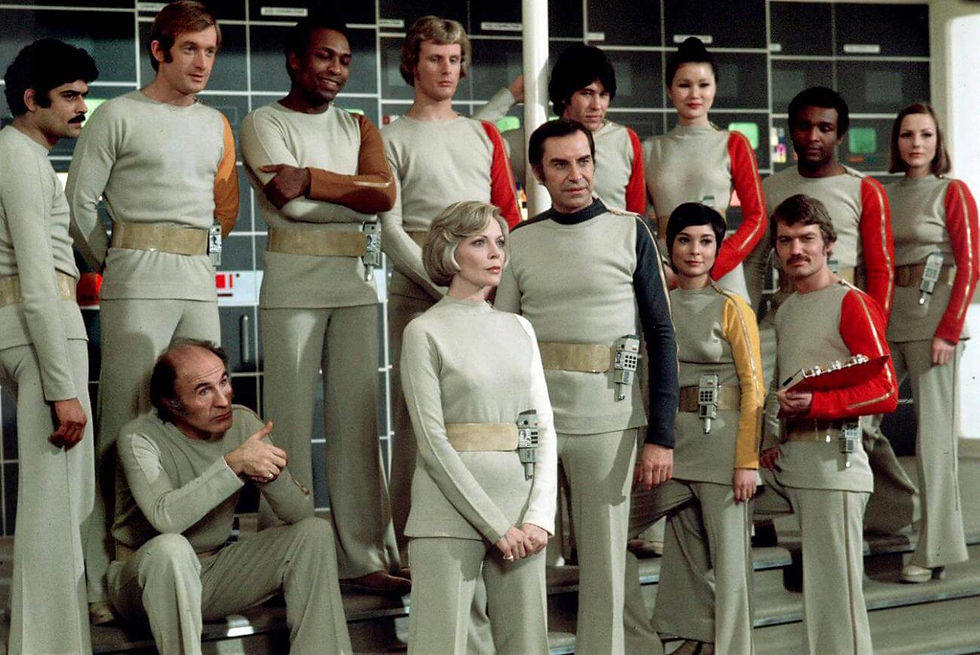Space 1999 - after fifty years, its legacy lives on
- Denise Breen

- Sep 2
- 6 min read
Updated: 3 days ago

Half a century ago, amidst a television scene filled with friendly starships and hopeful futures, a different kind of science fiction series sent a solitary moon into the cosmic void. "Space: 1999," which debuted on September 13, 1975, was more than just a show; it was an artistic statement, boldly and often unsettlingly exploring existential dread, cosmic indifference, and the profound isolation of being irretrievably lost. On its 50th anniversary, I wanted to pen an essay on its lasting appeal but more importantly on its impact on 10 year-old me. Space: 1999's breathtaking visuals and iconic design were unlike anything at the time. It blended the human optimism of Star Trek with horror and genuine scientific curiosity. Yes, its science was often a little off (magnetic radiation, anyone?) but its steadfast commitment to its bleak, beautiful vision makes Space: 1999 a unique and enduring masterpiece of the genre. Most importantly , it gave us one of the best, most realistic space ships ever - the workhorse of Moonbase Alpha, the magnificent Eagle Transporter.
The genius of Space: 1999 starts with its bold and tragic premise. In the year 1999, humanity has set up Moonbase Alpha, an advanced research and monitoring station with a multicultural crew. It was a base where deep space missions were developed and launched. It also monitored the condition of the nuclear waste dumps on the far side of the moon. Yes, by 1999 we had solved the nuclear waste problem by shipping it all to the moon! However, a disastrous chain reaction in nuclear waste area 2 on the Moon's far side propels Earth's satellite out of its orbit, sending it into deep space.

This singular, catastrophic event lays the groundwork for a story that fundamentally challenges the conventions of its era. Unlike the USS Enterprise, which sought new life and civilizations, the crew of Moonbase Alpha were not explorers; they were victims. They are not on a mission; they are cosmic refugees, drifting without a purpose beyond survival. It's a message that is still relevant today. The premise allowed the series to delve into themes of cosmic horror and profound loneliness that few of its contemporaries dared to explore.
Year One's episodes, in particular, were often philosophical tales rather than mere adventures. "The Guardian of Piri" tackled the tempting yet ultimately soul-destroying nature of a perfect, automated existence. "Missing Link" examined the tragic fate of a being who has transcended physical form, trapped in a lonely intellectual hell. The show's universe was not filled with clear-cut villains or friendly aliens; it was a realm of cosmic strangeness and often-lethal indifference. From a sentient black sun to beings living as patterns in space, the phenomena encountered by the Alphans were less about good versus evil and more about the universe's fundamental incomprehensibility. This intellectual, cerebral approach was a double-edged sword that alienated some viewers but formed a deep bond with those seeking science fiction beyond mere escapism.
Indeed, one episode in Season one, "Dragon's Domain" the Alphans (as the residents on Moonbase Alpha called themselves) encountered a space dragon of sorts. At ten years of age, it was the stuff of nightmares and I have no idea how it was shown on TV early in the evening. As a single, stand-alone episode, it is cinematic, moving and terrifying.

Nevertheless, the show's most undeniable and widely acclaimed legacy is its aesthetic. Created by Gerry and Sylvia Anderson, who perfected their craft with the detailed models and intricate puppetry of Thunderbirds and UFO, Space: 1999 brought an unprecedented level of cinematic quality to television. The production design, led by visionary Keith Wilson, was a triumph of functionalist futurism. Moonbase Alpha was a masterpiece of set construction—stark whites, clean lines, and technological minimalism. It felt like a plausible, operational scientific outpost, a sterile sanctuary against the chaos of space. The costumes, designed by award-winning designer, Rudi Gernreich were a simple yet effective blend of jumpsuits and professional uniforms, reinforced the idea that these were not adventurers, but professionals working under extreme conditions. The technology too, the ubiquitous commlink - both electronic door key, computer controller and video communications device - was a brilliant, functional piece of believable technology

No discussion of the show’s visuals is complete without praising the Eagle Transporter. Designed by Brian Johnson and his team, the Eagle is arguably the most iconic and beloved spacecraft in television history, second only to the Starship Enterprise. With its modular pod system, open-framework spine, and powerful retro thrusters, the Eagle was a marvel of model design. It looked functional, rugged, and entirely believable. Johnson’s special effects work with these models was groundbreaking. Using large-scale models, complex motion-control cameras, and intricate pyrotechnics, the show’s effects sequences were not just impressive for television; they rivaled feature films of the era. The sight of an Eagle launching from the base, or navigating a dangerous asteroid field, remains as thrilling today as it was fifty years ago. This dedication to practical effects gives the show a timeless quality that early CGI-heavy productions often lack. The explosions, the debris, the sense of weight and scale—it all feels real, a testament to the skill and artistry of the production team.
While the visual splendour was a major draw, the emotional core of the show rested on the shoulders of its leading players, the married couple, Martin Landau and Barbara Bain. As Commander John Koenig and Dr. Helena Russell, they brought a professional stoicism that perfectly matched the show's detached, intellectual tone. Their relationship was not one of romantic melodrama, but of mutual respect and quiet strength. Koenig was the pragmatic leader, burdened by the responsibility of 311 lives, forced to make impossible decisions in a hostile universe. Russell was the compassionate physician, the moral compass who reminded him of the human cost of every choice. The frequent criticism of the characters being “cold” or lacking emotional range misses the point. Their emotional reserve was a feature, not a flaw. They were not a surrogate family; they were highly trained professionals under unimaginable stress, and their cold exterior was the only way to maintain sanity in the face of cosmic absurdity.

Despite the praise, Space: 1999 was a show of two distinct halves, reflecting its troubled yet resilient nature, Seasons 1 and 2 are completely different. The change in leadership for Season Two saw Sylvia Anderson's departure and the arrival of producer Fred Freiberger, who had previously led the third season of Star Trek. This resulted in a significant shift in tone. The show became more action-oriented, with less philosophical introspection and more monster-of-the-week plots. The introduction of the shapeshifting alien Maya, played with delightful charm by Catherine Schell, and the gruff Tony Verdeschi (Tony Anholt), injected new energy and humour into the series. While some purists mourned the loss of Year One’s cerebral core and Professor Victor Bergman - played by the delightful Barry Morse, Year Two had its own merits. Episodes like "The Metamorph" or "Brian the Brain" still delivered a powerful and imaginative punch, and the new, faster pace made it more accessible to a broader audience. The two seasons, though different, represent a fascinating cultural artifact: a show that was so ahead of its time it had to be pulled back to meet it, only to find a new kind of creative footing.
As we celebrate the 50th anniversary of Space: 1999, its legacy endures. It’s a show that was ahead of its time, not in its technological predictions, but in its profound thematic concerns. In an age of climate change, global instability, and a renewed sense of human fragility, the story of a lost people, refugees searching for a new home resonates more powerfully than ever. The quiet horror of cosmic solitude, the struggle for survival against impossible odds, and the constant search for meaning in a seemingly indifferent universe—these are the timeless questions that Space: 1999 asked, and they are the same questions we continue to grapple with today.

It was not a show for everyone, and it never tried to be. It was a show for the dreamers who looked up at the moon and wondered not just what was on it, but what might happen if it were no longer there. It was a show for the artists who saw beauty in a perfect vacuum and the scientists who found terror in the unknown. Space: 1999 remains a defiant, brilliant, and unforgettable journey into the heart of the cosmos, a singular achievement that deserves its place in the highest pantheon of science fiction television. Fifty years on, the Moon continues its lonely flight, and we can only be grateful we were able to watch it go.






Comments